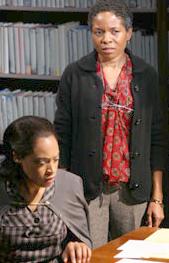SITE GUIDE
SEARCH
REVIEWS
REVIEW ARCHIVES
ADVERTISING AT CURTAINUP
FEATURES
NEWS
Etcetera and
Short Term Listings
LISTINGS
Broadway
Off-Broadway
NYC Restaurants
BOOKS and CDs
OTHER PLACES
Berkshires
London
California
New Jersey
DC
Philadelphia
Elsewhere
QUOTES
TKTS
PLAYWRIGHTS' ALBUMS
LETTERS TO EDITOR
FILM
LINKS
MISCELLANEOUS
Free Updates
Masthead
Writing for Us
A CurtainUp Review
Ohio State Murders
|
The abyss in any form has a fascinating dual
significance. — Robert Hampshire
|

Cherise Boothe and LisaGay Hamilton
in Ohio State Murders
(Photo: Gerry Goodstein) |
Like several of Kennedy's plays, notably The Owl Answers and Funnyhouse of a Negro, Ohio State Murders makes fluid use of time. Set at Ohio State University in "the present," when alumna Suzanne Alexander (Lisa Gay Hamilton), a dramatist and short-story writer, is giving a lecture about "the violent imagery" in her work, the play moves back and forth between that present and the years 1949-1952, when Suzanne was an undergraduate (Cherise Boothe).
But where Owl and Funnyhouse, both written in the 1960s, are passionate, feverish cries for understanding—surreal, even messy nightmares of African-American experience—Ohio State Murders, first produced in 1990, is a comparatively cool, objective look at the brutality to which racial prejudice can lead. As narrated by the older Suzanne—a slim, straight-backed Hamilton, speaking to the audience in a nearly affectless voice—the story of how her college-age self was seduced by a white English professor named Robert Hampshire (Saxon Palmer), and how the children from that brief relationship were later murdered, is much more awful for being told in a distant, almost ladylike way.
Indeed, as smartly directed by Evan Yionoulis, this production accentuates the play's coolness. On the long, shallow stage of the Duke on 42nd Street, Neil Patel's set offers up bookcases and books that look a ghostly white, with only here and there a piece of stiff, uninviting modern furniture. Capping the effect, designer Christopher Akerlind washes the set with chilly light.
In this environment, even the performances feel muted. Hamilton's performance is restrained, and the few moments of passion—from Palmer's English professor, when he reads aloud passages from Thomas Hardy's Tess of the d'Urbervilles (a story that also involves a murder), or from the fine, expressive Boothe—are that much stronger for being isolated and selective.
The result is that Ohio State Murders becomes more than a play about one woman's experience of racial hatred in the United States. Suzanne's narrative conveys the terrible ease with which one group of people can victimize another, in the United States or anywhere. The events that have led to the violent imagery in Suzanne's fiction are both specific to her and, as we know all too well, horribly commonplace.
| OHIO STATE MURDERS By Adrienne Kennedy Directed by Evan Yionoulis Cast: LisaGay Hamilton (Suzanne Alexander, present); Saxon Palmer (Robert Hampshire); Cherise Boothe (Suzanne Alexander, 1949-1952); Julia Pace Mitchell (Iris Ann); Aleta Mitchell (Aunt Louise); Kobi Libii (David Alexander/Val) Sets by Neil Patel Costumes by Emilio Sosa; Lighting by Christopher Akerlind Original music and sound by Mike Yionoulis and Sarah Pickett Projection design by Leah Gelpe. Theater for a New Audience at the Duke on 42nd Street, 229 West 42nd Street, Manhattan; (646) 223-3010 or dukeon42.org Running time: 55minutes, without intermission From 10/27 to 11/18. opening 11/04/07. Tickets: single tickets $75 (3-play subscription, $126- $10 tickets are available through the New Deal ticket program for ages 25 and under. Tues to Sat at 8pm, Sat 2pm and Sun 3pm. reviewed by Alexis Greene on November 8th |
Try onlineseats.com for great seats to
Wicked
Jersey Boys
The Little Mermaid
Lion King
Shrek The Musical

The Playbill Broadway YearBook

Leonard Maltin's 2007 Movie Guide


Wicked
Jersey Boys
The Little Mermaid
Lion King
Shrek The Musical

The Playbill Broadway YearBook

Leonard Maltin's 2007 Movie Guide


